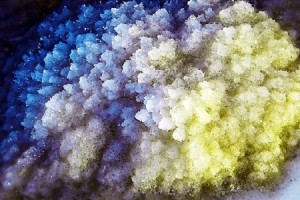
Copyright: maimento / 123RF Stock Photo
Wisconsin winters are bitter!
(AND the salt is technically bitter too)
In past articles we discussed how most soil is acidic and requires an alkaline cleaning solution to properly suspend the soil. Once the soil is suspended, a proper hot water rinse, neutralization and extraction will leave the carpet clean and soft.
On the other hand, salt that is used to melt snow and ice, tends to be alkaline (high pH) and will not easily be removed by using most cleaning solutions which are also a high pH).
In fact, the more cleaning solution used, the more the salt tends to attach itself to the carpeting and the fibers.
While the carpet is wet, the white powder residue from the salt seems to be gone, but as soon as the carpet is dry, it will reappear. This generally leads to the conclusion that the carpet is stained and beyond repair, but that isn’t always the case.Winter salt cleanup process
Last year, I went into a very high end retail establishment that was dealing with excessive salt residue. Prior to our service it was determined that the carpet was ruined and seemed to be in need of replacement. Our process involved several steps to revive this carpeting, which are the same steps we use for other similar situations:
- Agitate the carpeting with a counter rotating brush machine–A mechanical agitation machine will scrub all sides of the carpet fiber. This will loosen the salt from the carpeting fiber.
- Vacuum the dry soil.
- Clean the carpet with an alkaline cleaning solution & rinse with a high pressure & hot water. A high volume restoration machine (see video below) is ideal.

- Rinse out all solution
- Apply an acidic-based cleaning solution (be careful not to come in contact with natural stone or other delicate fabrics)
- Agitate the solution into the carpet, which will begin to suspend the salt
- Rinse thoroughly and dry quickly.
 This picture demonstrates how the salt removal process can make a dramatic difference to the look of the carpeting. Even though our process removed an incredible amount of soil, salt and other contaminates, this carpeting still required an additional visit to be flushed out two more times to properly remove all of the salt buildup.
This picture demonstrates how the salt removal process can make a dramatic difference to the look of the carpeting. Even though our process removed an incredible amount of soil, salt and other contaminates, this carpeting still required an additional visit to be flushed out two more times to properly remove all of the salt buildup.
It is important for a professional cleaner to understand the process to remove salt is very different than the process to remove soil.
Preparations for the winter
Every situation–office, building, commercial, residential, factory–is unique. If you are still uncertain how to handle your facility after reading these guidelines, please call me directly at (262) 297-4981 and I will be able to help you in creating a strategy for winter.
- Use walk-off mats: Every outside entrance should have walk-off mats. There are many services out there that come to your facility weekly, bi-weekly or even monthly to replace your mats with clean and fresh mats. My standard recommendation is bi-weekly for most office spaces during the storm season.
- Vacuum: After the carpet is dry from the most recent snow storm (last year I think we might have had a couple of days), vacuum the carpets in several directions. By vacuuming in two different directions, all sides of the carpet fiber will be adequately agitated. Ideally, the use of a counter-rotating brush (CRB) machine will help facilitate this.
- Limit amount of salt used: Sometimes it looks like the bucket of salt was just poured out on the ground versus scattering the salt. Once the snow has stopped, remove all excess salt. If not, this salt will just migrate to your carpeting.
- Use a liquid de-icer: These products are becoming more popular. They are usually applied prior to a storm with a pump up sprayer and lasts 2-3 days after application (sometimes longer)
- Post-storm carpet extraction: If you are responsible for a high traffic facility, consider having a professional carpet cleaning company (Bluegreen) come in and clean and extract all entrances one to two days post storm.
Copyright: ursula1964 / 123RF Stock Photo
It is important to remember that salt is a hard crystal with sharp edges and very abrasive. Failure to remove the salt that is left in the carpeting will cut and fray the carpet fibers making the carpet look worn and dull over time.
Be a hero to your facility and keep the salt away!
